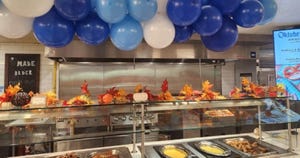
These innovative eateries are ones to watch.
Making the most of every ingredient
At John Knox Village, close communication and creative thinking boost efficiencies in the back of house.
August 9, 2021

Senior-living facility John Knox Village in Lee's Summit, Mo., is well named: It’s a little town unto itself, with close to 1,500 residents on the 400-acre campus. And its 130-plus foodservice staffers are busy serving as many as 1,700 meals a day across six kitchens and nine restaurants.
From the cafeteria to the lakeside grill to the gastropub, not only are the people working hard at John Knox—the ingredients are, too.
Director of Dining and Event Services Todd Hollander has built a culture of cross-utilization, in which products are used across multiple dishes in creative and unique ways, and staffers across the concepts are in constant touch about what everyone’s got cooking.
“It’s just become part of our culture: If someone’s suggesting we buy a new product, they know to come in with two or three or four ideas about other [dishes] where we can use it,” Hollander says. “It pushes you to be creative and totally remix those ingredients for something brand new.”
Doing double duty
Take, for example, the Buddha Bowl entree at the village’s Courtyard Cafe. The $8.50 dish is filled with ruby wild rice, green garbanzo beans, peas, radishes and carrots, and topped with a carrot-ginger dressing.
All of those ingredients connect out to other dishes. The chickpeas and wild rice, for example, become a base for the Garden Patch Burger, which also uses the carrots and adds broccoli, onions, oats, carrots, spinach and bell peppers. The Buddha Bowl’s peas are used in Bangers and Mash as well as an a la carte pasta topper. The carrot-ginger dressing is used as an option for regular salads. And so on.
“We take that one Buddha Bowl, deconstruct it and create something else — but the resident looking at the menu doesn’t see how a bowl and a burger are related,” Hollander explains. “It feels fresh and new for them, while helping cut down on food waste for us. A total win-win.”
Cross-utilization has become part of the everyday conversation, he adds, permeating the culture and the plans from minute one.
“Someone wanted to bring in a Tuscan salad with artichokes, for example,” Hollander says. “Those can be pricey, so I immediately said, ‘Great! What else can we do with it? Where else are you planning to use them?’”
Hollander no longer needs to prompt that conversation, however. It’s become part of the expectation that “for every product we want to bring in, we need to use it for one or two additional menu items at a minimum,” he explains. “Now people come to me with that list already prepared, which is fantastic.”

Photo courtesy of John Knox Village
That principle has come in handy during times of COVID-fueled tight supply, but cross-utilization has long been a way of life at John Knox. And it’s about more than just streamlining food waste.
This kind of culture also breeds communication and collaboration, says Caleb Krenning, manager of the Meadows Dining facility, home to the international-themed Metropolitan and gastropub-style Stories Public House.
“We stay in close touch with each other as chefs: 'We’re doing this special, making this new menu, having this issue with supply from a certain distributor,'” Krenning says. “We also ask plenty of questions: 'How did that special do for you guys? Can we come over and try it?'”
Keeping connected
With nine concepts, daily specials and seasonal menu changes that aim to switch out 25% of the options, close communication is key.
For example, because the Courtyard Cafe is closer to Meadows Dining, Krenning’s restaurants won’t plan Mexican daily specials on Courtyard’s Taco Tuesdays. And if the Courtyard folks run low on chips or refried beans, they know they’re welcome to run over to Stories or Metropolitan to stock up.
Hollander credits that aligned teamwork with the success of the meal delivery solution and curbside service his team developed during COVID, which utilized the Dial-A-Ride van service that runs through campus.
“The biggest thing is to just start talking, and to avoid that feeling that’s common in restaurants that you’re an island,” Krenning says. “That’s a myth. Sometimes you have to pull your head out of the sand, out of that day’s service. Pick up the phone or walk down the hall and ask: ‘What’s going on at your place? How can we help each other?’ It can be as simple as that.”
About the Author
You May Also Like




